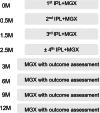One-year outcome of intense pulsed light therapy for refractory meibomian gland dysfunction in patients continuously exposed to topical glaucoma medications: a comparative study
- PMID: 40604189
- PMCID: PMC12325904
- DOI: 10.1038/s41433-025-03886-z
One-year outcome of intense pulsed light therapy for refractory meibomian gland dysfunction in patients continuously exposed to topical glaucoma medications: a comparative study
Abstract
Background: To evaluate the one-year effect of intense pulsed light (IPL) for refractory meibomian gland dysfunction (MGD) between patients treated with and without topical hypotensive agents.
Methods: This retrospective study included 21 MGD eyes of 21 glaucoma patients (age, 64.38 ± 13.74 years) and 21 MGD eyes of 21 non-glaucoma patients (age, 63.90 ± 13.50 years). Both arms received IPL therapy with meibomian gland expression (MGX). Propensity score matching ensured baseline comparability. Standard Patient Evaluation of Eye Dryness (SPEED) questionnaire, tear film breakup time (TBUT), lid telangiectasia, corneal staining, meibum quality and expressibility were assessed at baseline, 3-, 6-, 9- and 12-months post-treatment.
Results: Both groups showed significant improvement in SPEED score and TBUT at 9 months, but only the non-glaucoma group maintained these improvements at 12 months (P < 0.01). While meibum quality improved in both groups at 12 months, significant improvement in lid telangiectasia and meibum expressibility was observed only in the non-glaucoma group. At 12 months, the non-glaucoma group showed less lid telangiectasia than the glaucoma group (P = 0.009). No other intergroup differences were found in other outcomes. Neither group showed significant improvement in corneal staining throughout the follow-up period.
Conclusions: IPL therapy is effective for treating refractory MGD in both glaucoma and non-glaucoma patients, with significant improvements in dry eye symptoms, tear film stability and meibum quality. However, patients on continuous hypotensive agents showed less improvement in lid telangiectasia at 12 months, suggesting that chronic hypotensive medication use may affect treatment efficacy.
© 2025. The Author(s).
Conflict of interest statement
Competing interests: The authors declare no competing interests.
Figures


Similar articles
-
Safety and efficacy of a novel intense pulsed light system in patients with meibomian gland dysfunction: a randomized, double-masked, intra-individual controlled study.Int Ophthalmol. 2025 Jun 16;45(1):246. doi: 10.1007/s10792-025-03622-2. Int Ophthalmol. 2025. PMID: 40524073 Clinical Trial.
-
A Short-Term Comparative Evaluation of Multiple Treatment Modalities for Meibomian Gland Dysfunction: A Prospective Clinical Study.Healthcare (Basel). 2025 Aug 14;13(16):1992. doi: 10.3390/healthcare13161992. Healthcare (Basel). 2025. PMID: 40868608 Free PMC article.
-
Therapeutic efficacy of intense pulsed light in patients with refractory meibomian gland dysfunction.Ocul Surf. 2019 Jan;17(1):104-110. doi: 10.1016/j.jtos.2018.11.004. Epub 2018 Nov 13. Ocul Surf. 2019. PMID: 30445177 Clinical Trial.
-
Multifaceted behavioral interventions to improve topical glaucoma therapy adherence in adults.Cochrane Database Syst Rev. 2025 Jun 11;6(6):CD015788. doi: 10.1002/14651858.CD015788.pub2. Cochrane Database Syst Rev. 2025. PMID: 40497459 Review.
-
Intense pulsed light (IPL) therapy for the treatment of meibomian gland dysfunction.Cochrane Database Syst Rev. 2020 Mar 18;3(3):CD013559. doi: 10.1002/14651858.CD013559. Cochrane Database Syst Rev. 2020. PMID: 32182637 Free PMC article.
References
-
- Fineide F, Lagali N, Adil MY, Arita R, Kolko M, Vehof J, et al. Topical glaucoma medications - Clinical implications for the ocular surface. Ocul Surf. 2022;26:19–49. - PubMed
-
- Ramli N, Supramaniam G, Samsudin A, Juana A, Zahari M, Choo MM. Ocular surface disease in glaucoma: effect of polypharmacy and preservatives. Optom Vis Sci. 2015;92:e222–6. - PubMed
-
- Teo CHY, Ong HS, Liu YC, Tong L. Meibomian gland dysfunction is the primary determinant of dry eye symptoms: analysis of 2346 patients. Ocul Surf. 2020;18:604–12. - PubMed
-
- Soriano D, Ferrandez B, Mateo A, Polo V, Garcia-Martin E. Meibomian gland changes in open-angle glaucoma users treated with topical medication. Optom Vis Sci. 2021;98:1177–82. - PubMed
Publication types
MeSH terms
Substances
LinkOut - more resources
Full Text Sources
Medical

